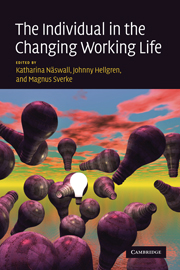Book contents
- Frontmatter
- Contents
- List of figures
- List of tables
- List of cases
- List of contributors
- Acknowledgements
- 1 The individual in the changing working life: introduction
- Part I Threats and challenges
- 2 New rules of work: exploring the boundaryless job
- 3 Changing work roles: new demands and challenges
- 4 The Demand-Induced Strain Compensation model: renewed theoretical considerations and empirical evidence
- 5 Job insecurity and employability among temporary workers: a theoretical approach based on the psychological contract
- 6 Independent contracting: finding a balance between flexibility and individual well-being
- 7 Work–family conflict in individuals' lives: prevalence, antecedents, and outcomes
- 8 My love, my life, my everything: work–home interaction among self-employed
- 9 Modern work and safety
- 10 Romantic relationships at work: old issues, new challenges
- 11 Ethnic diversity at work: an overview of theories and research
- Part II Individual attempts at restoring the balance
- Part III Intervention and promotion on the organizational level
- Index
- References
9 - Modern work and safety
Published online by Cambridge University Press: 13 October 2009
- Frontmatter
- Contents
- List of figures
- List of tables
- List of cases
- List of contributors
- Acknowledgements
- 1 The individual in the changing working life: introduction
- Part I Threats and challenges
- 2 New rules of work: exploring the boundaryless job
- 3 Changing work roles: new demands and challenges
- 4 The Demand-Induced Strain Compensation model: renewed theoretical considerations and empirical evidence
- 5 Job insecurity and employability among temporary workers: a theoretical approach based on the psychological contract
- 6 Independent contracting: finding a balance between flexibility and individual well-being
- 7 Work–family conflict in individuals' lives: prevalence, antecedents, and outcomes
- 8 My love, my life, my everything: work–home interaction among self-employed
- 9 Modern work and safety
- 10 Romantic relationships at work: old issues, new challenges
- 11 Ethnic diversity at work: an overview of theories and research
- Part II Individual attempts at restoring the balance
- Part III Intervention and promotion on the organizational level
- Index
- References
Summary
This chapter is concerned with safety within contemporary work contexts from a work and organizational psychology perspective. The aim of the chapter is to provide a critical appreciation of the contribution of recent questionnaire studies to modern work and safety issues in light of previous work on human error.
Background
The scientific study of safety at work has been characterized by Hale and Hovden (1998) as having three ages. The first age was concerned with “technical measures to guard machinery, stop explosions and prevent structures collapsing” (p. 129) and lasted from the nineteenth century until after 1945. The second age, initiated between the two world wars, witnessed research into prevention measures based on personnel selection, training, and motivation, often referred to as theories of accident proneness. Hale and Hovden indicate that the technical and individual-based approaches merged in the 1960s and 70s with developments in ergonomics and probabilistic risk analysis, and the study of human error as a field of inquiry. They go on to identify the 1980s as characterized by “an increasing dissatisfaction with the idea that health and safety could be captured simply by matching the individual to technology” (p. 130) and that the 1990s were well into the third age of safety.
The third age Hale and Hovden (1998: 130) characterize as focused on management systems, and the literature, to the 1980s at least, as “accumulated common sense and as general management principles applied to the specific field of safety” rather than science.
- Type
- Chapter
- Information
- The Individual in the Changing Working Life , pp. 169 - 194Publisher: Cambridge University PressPrint publication year: 2008

